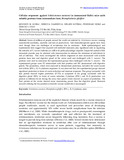Cellular responses against Schistosoma mansoni in immunized Balb/c mice with soluble proteins from intermediate host, Biomphalaria pfeifferi

View/
Date
2012-10Author
Muna, Kennedy K.
Waihenya, R.
Kutima, H.
Njoki, P.
Yole, D. S.
Metadata
Show full item recordAbstract
Scores of millions of people around the world are infected by Schistosoma mansoni causing considerable morbidity, mortality and loss of productivity. Safe chemotherapeutic agents have been used though there are challenges of re-infection due to resistance. Both epidemiological and experimental data suggest that acquired cell mediated immunity play significant roles in regulating the intensity of S. mansoni infection as well as its patho-physiologic sequelae. Improved control of this trematode parasite may be obtained with immunization to enhance the resistance of individuals to risk of infection. This study investigated the cellular responses of mice immunized with soluble proteins from foot and digestive gland of the vector snail and challenged with S. mansoni. The proteins were used to immunize the experimental groups then challenged with the S. mansoni. The
experimental groups were FT (immunized with foot protein) and DG (immunized with digestive gland). The parameters, which were analyzed to demonstrate protection, included; the worm counts and cellular (IFN-γ, IL-5 cytokines) responses. It was observed that, the experimental groups showed significant protection in terms of worm reduction and immune responses. The group vaccinated with foot protein showed higher protection (87.5%) as compared to the group vaccinated with the digestive gland (50%) in terms of worm reduction. Cytokines (IFN-γ and IL-5) production was present in different levels during the assay time points which showed an aspect of protection. The Foot protein of the vector showed more immunizing power than the digestive gland. Research towards utilizing the two proteins as feasible vaccine candidates is encouraged.
URI
https://pubmed.ncbi.nlm.nih.gov/26591726/https://www.ajol.info/index.php/thrb/article/view/64959
http://hdl.handle.net/123456789/4576
